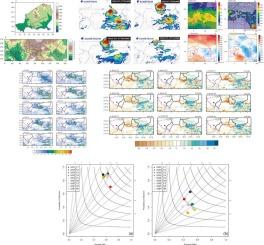Numerical simulations of a heavy rainfall event in the Sahelian region of Zinder in Niger
IF 4.4
2区 地球科学
Q1 METEOROLOGY & ATMOSPHERIC SCIENCES
引用次数: 0
Abstract
Reliable modeling of heavy rainfall events is required for accurate flood prediction. This study evaluated the performance of the Weather Research and Forecasting (WRF) model in simulating heavy rainfall events that occurred on July 17, 2022 in the Sahelian region of Zinder in Niger. We performed a sensitivity study using various cumulus and microphysical schemes. We evaluated the reliability of the WRF model using different statistical approaches, including the probability of detection, false alarm ratio, success ratio, frequency bias, and critical success index. At the synoptic scale, atmospheric conditions were favorable for heavy precipitation in the Zinder region. Intense moisture transport from the southwest, high precipitable water values (≥ 50 kg/m2), strong wind shear (10–15 m/s) and convective instability indicators (high K index and low convective inhibition) contributed to the initiation and intensification of convection. Outgoing longwave radiation (OLR) analysis confirmed the presence of strong convective activity and an active easterly wave, which strengthened the organization of convective systems. The evaluation analysis showed that the model effectively captured the spatial pattern of heavy rainfall in all ensemble member simulations. When combined with the Purdue Lin (PL), Morrison-2 moment (M2), and New Thomson (TS) microphysical schemes, the Tiedkte (TK) cumulus scheme outperformed other convective schemes. The WRF model has the potential to improve the prediction of heavy rainfall events in Niger and to inform decision-making processes.

尼日尔津德尔萨赫勒地区强降雨事件的数值模拟
准确的洪水预报需要可靠的暴雨事件模拟。本研究评估了气象研究与预报(WRF)模型在模拟2022年7月17日发生在尼日尔Zinder萨赫勒地区的强降雨事件中的表现。我们使用各种积云和微物理方案进行了灵敏度研究。我们使用不同的统计方法来评估WRF模型的可靠性,包括检测概率、虚警率、成功率、频率偏差和临界成功指数。在天气尺度上,Zinder地区的大气条件有利于强降水。来自西南的强水汽输送、高可降水量(≥50 kg/m2)、强风切变(10 ~ 15 m/s)和对流不稳定指标(高K指数和低对流抑制)对对流的产生和增强起促进作用。发射长波辐射(OLR)分析证实存在强对流活动和一个活跃的东风波,加强了对流系统的组织。评价分析表明,该模式有效地捕捉了暴雨的空间格局。当与Purdue Lin (PL)、Morrison-2矩(M2)和New Thomson (TS)微物理格式结合使用时,Tiedkte (TK)积云格式优于其他对流格式。WRF模型有可能改善对尼日尔强降雨事件的预测,并为决策过程提供信息。
本文章由计算机程序翻译,如有差异,请以英文原文为准。
求助全文
约1分钟内获得全文
求助全文
来源期刊

Atmospheric Research
地学-气象与大气科学
CiteScore
9.40
自引率
10.90%
发文量
460
审稿时长
47 days
期刊介绍:
The journal publishes scientific papers (research papers, review articles, letters and notes) dealing with the part of the atmosphere where meteorological events occur. Attention is given to all processes extending from the earth surface to the tropopause, but special emphasis continues to be devoted to the physics of clouds, mesoscale meteorology and air pollution, i.e. atmospheric aerosols; microphysical processes; cloud dynamics and thermodynamics; numerical simulation, climatology, climate change and weather modification.
 求助内容:
求助内容: 应助结果提醒方式:
应助结果提醒方式:


